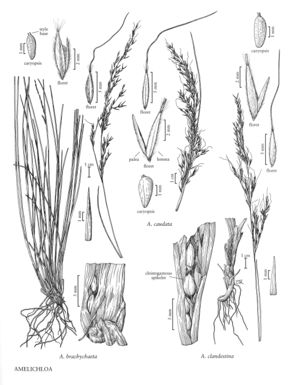| Taxon | Illustrator ⠉ | |
|---|---|---|
 | Amelichloa brachychaeta Amelichloa caudata Amelichloa clandestina | Cindy Roché Cindy Roché Cindy Roché |
Plants perennial; cespitose. Culms erect, with 2-3 nodes, not branching at the upper nodes; basal branching intravaginal; prophylls concealed by the leaf-sheaths, winged over the keels, apices bifid, teeth 0.5-3.5 mm. Leaves mostly basal; sheaths open, smooth, glabrous; cleistogenes often present, spikelets of cleistogenes 0.5-1 mm long, with thin glumes shorter than the florets, florets unawned or with reduced awns; auricles absent; ligules scarious, rounded to acute, ciliate; blades stiff, involute, apices stiff, brown, sharply pointed, blades of the flag leaves 5-13 cm long, bases similar in width to the top of the sheaths. Inflorescences panicles, the main panicle terminal, apparently wholly chasmogamous. Spikelets with 1 floret; disarticulation above the glumes, beneath the floret. Glumes exceeding the floret, acute to acuminate, 1-5-veined; florets fusiform, terete; calluses antrorsely strigose, blunt; lemmas pubescent, often more densely and/or more persistently so over the midvein and lateral-veins, hairs on the proximal portion about 0.7-2 mm, hairs on the distal portion often longer; crowns not developed; awns once or twice-geniculate, scabrous, persistent; paleas 3/4 as long as to almost equaling the lemmas, flat, hairy, hairs 0.2-1 mm, veins terminating at or near the apices, apices similar in texture to the body; lodicules 3; anthers 3, anthers sometimes all of equal size and more than 2 mm, sometimes 1 longer than 2 mm and 2 much shorter, sometimes all shorter than 2 mm; ovaries glabrous; styles with 2 branches, united at the base, stigmas plumose. Caryopses obovoid, with 3 smooth, longitudinal ribs at maturity, stylar bases 1-2 mm, persistent, sometimes eccentric; hila linear, about as long as the caryopses. x = unknown.
Discussion
Amelichloa includes five species, four of which are South American. The fifth species, A. clandestina, grows in northern Mexico. Two species are established in the Flora region. A third species, A. caudata. was found on ballast dumps near Portland, Oregon, at the turn of the twentieth century; it is not established in the region.Cattle avoid species of Amelichloa because of their sharply pointed leaves. This means that any of the species could become a serious problem in rangelands. Mowing favors their establishment and spread because it does not eliminate, and may disperse, the cleistogenes. The species are eaten by goats.
Selected References
Key
| 1 | Mature caryopses with inclined, eccentric stylar bases; lemmas glabrous or hairy between the lateral and marginal veins, glabrous between the midvein and the lateral vein, even at the base | Amelichloa caudata |
| 1 | Mature caryopses with erect, usually centric stylar bases; proximal 1/2 of the lemmas pubescent between the lateral and marginal veins, at least initially, usually also between the midvein and lateral veins. | > 2 |
| 2 | Florets 4-5.5 mm long; ligules 0.2-0.6 mm long; anthers 2-3 mm long | Amelichloa brachychaeta |
| 2 | Florets 5.5-8 mm long; ligules 0.5-1.5 mm long; anthers 3-4 mm long | Amelichloa clandestina |
"decumbent" is not a number."prolonged" is not a number.